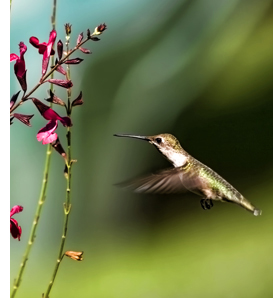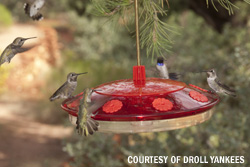 The tiny Ruby-throated Hummingbird easily captures the hearts of backyard birders with its bold, precise movements and bright iridescent colors. Summer visitors, Ruby-throated Hummingbirds complete a migration each spring and fall that seems impossibly far for such tiny creatures.
The tiny Ruby-throated Hummingbird easily captures the hearts of backyard birders with its bold, precise movements and bright iridescent colors. Summer visitors, Ruby-throated Hummingbirds complete a migration each spring and fall that seems impossibly far for such tiny creatures.
Identification
Ruby-throated Hummingbirds are only 3–3.5” long with a 4” wingspan. Both sexes sport a jewel-like green coat with a whitish belly. Males feature an iridescent throat that can look dark in certain light. A long, thin bill houses a 15–20mm long tongue with a brushy, textured tip that allows it to quickly lap up nectar.
Nesting and Habitat
Ruby-throated Hummingbirds live in open woodland, parkland, backyards, and meadows. Females build a tiny walnut-sized cup-shaped nest using soft plant material, moss, and a lining of spider webs. Males only stay with the female long enough to mate, but they’ll defend their territory before and after mating. Female hummingbirds typically lay two eggs that look like small jellybeans.
Range
The Ruby-throated Hummingbird is the only species typically seen in the eastern US including Minnesota. Their summer nesting habitat is the eastern US and into Canada; they winter in Central America. The northward migration of Ruby-throated Hummingbirds in spring coincides with the flowering of key plants along their route. Recent studies have also shown that hummers follow the migration of the Yellow-bellied Sapsucker.
 Attracting and Feeding
Attracting and Feeding
Ruby-throated Hummingbirds consume nectar and add tiny insects for protein. You can supply liquid nectar in a feeder or strategically plant nectar-rich plants such as fuchsia, salvia, zinnias, nicotiana, honeysuckle and petunias to attract these colorful birds. For best results, opt for red-colored blossoms.
Select a hummingbird feeder that’s easy to clean and fill. Many come with bee or nectar guards to help keep insects away from the nectar solution. A natural way to deter insects from nectar is to apply mint extract to the feeding ports.
Place the feeder near perching sites, like trees or shrubs, or near flowering plants. Make sure there’s at least 2–3 feet under your feeder. Hummingbirds are very bold, so don’t worry about putting the feeder too close to a house or window.
For more information, visit our Attracting Hummingbirds page or pick up our Attracting Hummingbirds handout in our stores.

